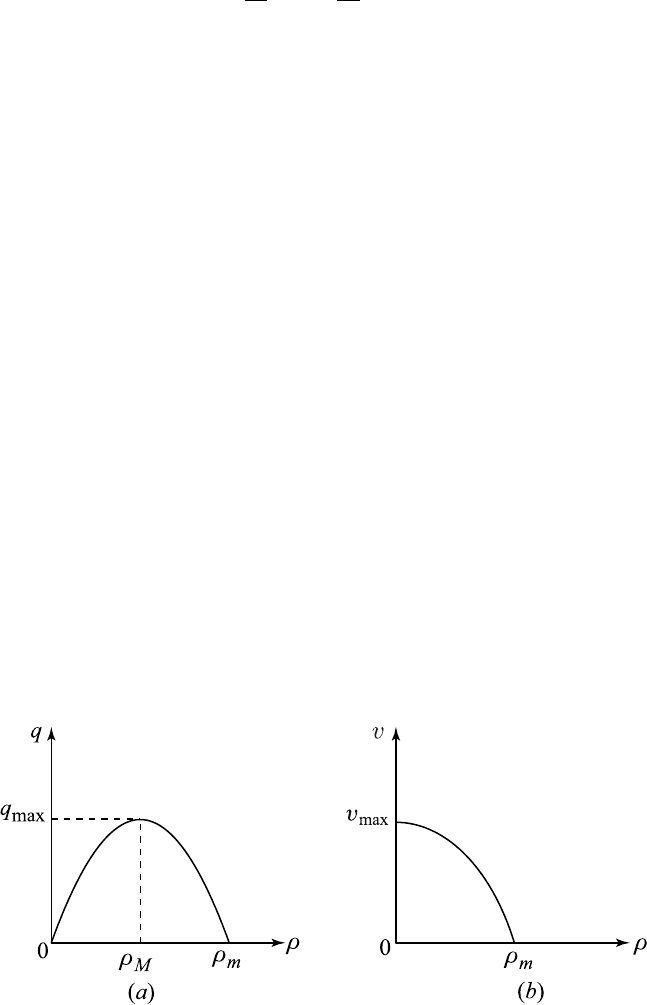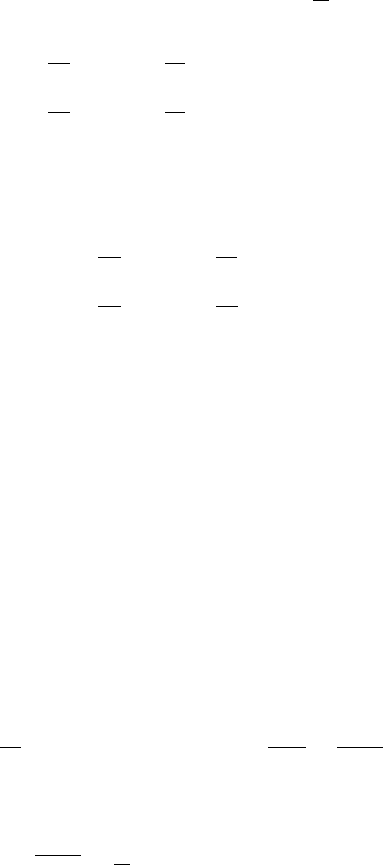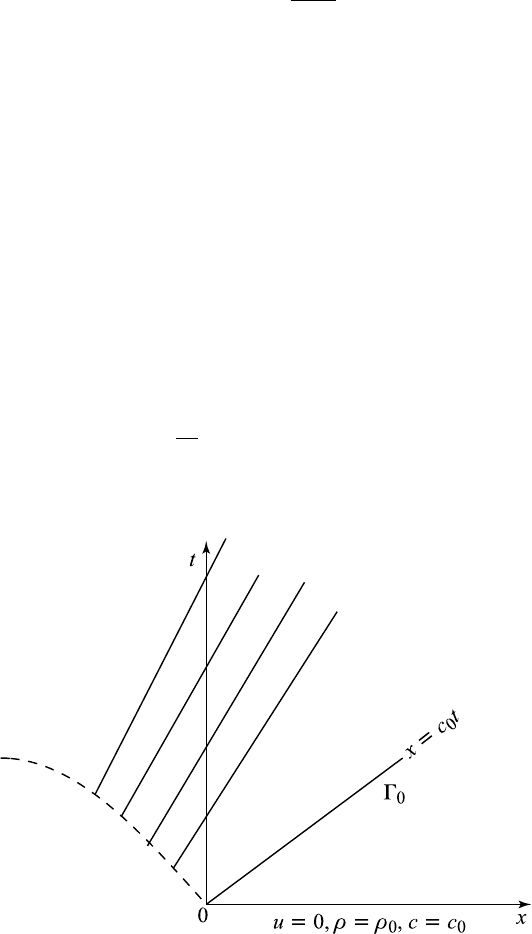Myint Tyn U., Debnath L. Linear Partial Differential Equations for Scientists and Engineers
Подождите немного. Документ загружается.


13.6 The Traffic Flow Model 551
∂ρ
∂t
+ c (ρ)
∂ρ
∂x
=0, (13.6.6)
where
c (ρ)=q
′
(ρ)=v + ρv
′
(ρ) . (13.6.7)
In general, the local velocity v (ρ) is a decreasing fun ction of ρ so that
v (ρ) has a finite maximum value v
max
at ρ = 0 and decreases to zero at
ρ = ρ
max
= ρ
m
. For the value of ρ = ρ
m
, the cars are bumper to bumper.
Since q = ρv, q (ρ)=0whenρ = 0 and ρ = ρ
m
. This means that q is an
increasing function of ρ until it attains a maximum value q
max
= q
M
for
some ρ = ρ
M
and then decreases to zero at ρ = ρ
m
. Both q (ρ)andv (ρ)
are shown in Fi gure 13.6.1.
Equation (13.6.6) is similar to (13.2.1) with the wave propagation ve-
locity c (ρ)=v (ρ)+ρv
′
(ρ). Since v
′
(ρ) < 0, c (ρ) <v(ρ), that is, the
propagation velocity is less than the car velocity. In other words, waves
propagate backwards through the stream of cars, and drivers are warned of
disturbances ahead. It follows from Figure 13.6.1a that q (ρ) is an i ncreasing
function in [0,ρ
M
], a decreasing function in [ρ
M
,ρ
m
], and attains a max-
imum at ρ
M
. Hence, c (ρ)=q
′
(ρ) is positive in [0,ρ
M
], zero at ρ
M
and
negative in [ρ
M
,ρ
m
]. All these mean that waves propagate forward relative
to the highway in [0,ρ
M
], are stationary at ρ
M
, and then travel backwards
in [ρ
M
,ρ
m
].
We use Section 13.1 to solve the initial-value problem for the nonlinear
equation (13.6.6) with the initial condition ρ (x, 0) = f (x). The solution is
ρ (x, t)=f (ξ) ,x= ξ + tF (ξ) , (13.6.8)
where
F (ξ)=c (f (ξ)) .
Figure 13.6.1 Graphs of q (ρ) and v (ρ).

552 13 Nonlinear Partial Differential Equations with Applications
Since c
′
(ρ)=q
′′
(ρ) < 0, q (ρ) is convex, and c (ρ) is a decreasing function
of ρ. This means that breaking occurs at the left due to formation of sho ck
at the back. Waves propagate slower than the cars, so drivers enter such
a l ocal density increase from behind; they must decelerate rapidly through
the shock but speed up slowly as they get out from the crowded area. These
conclusions are in accord with observational results.
Actual observational data of traffic fl ow indicate that a typical result
on a single lane highway is ρ
m
≈ 225 cars per mile, ρ
M
≈ 80 cars per mile,
and q
M
≈ 1590 cars p er hou r. Thus, the maximum flow rate q
M
occurs at
alowvelocityv = q
M
/ρ
M
≈ 20 miles per hour.
13.7 Flood Waves in Rivers
We consider flood waves in a long rectangular r iver of constant breadth. We
take the x-axis along the river which flows in the positive x-direction and
assume that the disturbance is approximately the same across the breadth.
In this problem, the depth h (x, t) of the river plays the role of density in
the traffic flow model discussed in Section 13.6. Let q (x, t) be the flow per
unit breadth and per unit time. According to the Conservation Law, the
rate of change of the mass of the fluid in any section x
1
≤ x ≤ x
2
must be
balanced by the net flux across x
2
and x
1
so that the conservation equation
becomes
d
dt
x
2
x
1
h (x, t) dx + q (x
2
,t) − q (x
1
,t)=0. (13.7.1)
An argument similar to the previous section gives
∂h
∂t
+
∂q
∂x
=0. (13.7.2)
Although the fluid flow is extremely complicated, we assume a simple func-
tion relation q = Q (h) as a first approximation to express the increase in
flow as the water level arises. Thus, equation (13.7.2) becomes
h
t
+ c (h) h
x
=0, (13.7.3)
where c (h)=Q
′
(h)andQ (h) is determined from the balance between the
gravitational force and the frictional force of the river bed. This equation
is similar to (13.2.1) and the method of solution has already been obtained
in Section 13.2.
Here we discuss the velocity of wave propagation for some particular
values of Q (h). One such result is given by the Chezy result as
Q (h)=hv, (13.7.4)

13.8 Riemann’s Simple Waves of Finite Amplitude 553
where v = α
√
h is the velocity of fluid flow and α is a constant, so that the
propagation velocity of flood waves is given by
c (h)=Q
′
(h)=
3
2
α
√
h =
3
2
v. (13.7.5)
Thus, the flood waves propagate one and a half times faster than the stream
velocity .
For a general case where v = αh
n
,
Q (h)=hv = αh
n+1
, (13.7.6)
so the propagation velocity of flood waves is
c (h)=Q
′
(h)=(n +1)v. (13.7.7)
This result also indicates that flood waves propagate faster than the fluid.
13.8 Riemann’s Simple Waves of Finite Amplitude
We consider a one-dimensional unsteady isentropic flow of gas of density
ρ and pressure p with the direction of motion along the x-axis. Suppose
u (x , t)isthex-component of the velocity at time t and A is an area-
element of the (y, z)-plane. The volume of the rectangular cylinder of height
dx standing on the element A is then Adx and its mass Aρ
t
dx dt is
determined by the mass entering it, which is equal to −A (∂/∂x)(ρu) dx dt.
Its acceleration is (u
t
+ uu
x
) and the force impelling it in the p ositive x-
direction is −p
x
Adx= −c
2
ρ
x
Adx,wherep = f (ρ)andc
2
= f
′
(ρ). These
results lead to two coupled nonlin ear partial differential equations
∂ρ
∂t
+
∂
∂x
(ρu)=0, (13.8.1)
(u
t
+ uu
x
)+
c
2
ρ
ρ
x
=0. (13.8.2)
In matrix form, this system is
A
∂U
∂x
+ I
∂U
∂t
=0, (13.8.3)
where U, A and I are matrices given by
U =
⎛
⎝
ρ
u
⎞
⎠
,A=
⎛
⎝
uρ
c
2
/ρ u
⎞
⎠
and I =
⎛
⎝
10
01
⎞
⎠
. (13.8.4)
The concept of characteristic curves introduced briefly in Section 13.2
requires generali zation if it is to be applied to quasi-linear systems of first-
order partial differential equations (13.8.1)–(13.8.2).

554 13 Nonlinear Partial Differential Equations with Applications
It is of interest to determine how a solution evolves with time t. Hence,
we leave the time variable unchanged and replace the space variable x by
some arbitrary curvilinear coordinate ξ so that the semi-curvilinear coor-
dinate transformation from (x, t)to(ξ, t
′
) can be introduced by
ξ = ξ (x, t) ,t
′
= t. (13.8.5)
If the Jacobian of this transformation is nonzero, we can transform
(13.8.3) by the following correspondence rule:
∂
∂t
≡
∂ξ
∂t
∂
∂ξ
+
∂t
′
∂t
·
∂
∂t
′
=
∂ξ
∂t
∂
∂ξ
+
∂
∂t
′
,
∂
∂x
≡
∂ξ
∂x
∂
∂ξ
+
∂t
′
∂x
∂
∂t
′
=
∂ξ
∂x
∂
∂ξ
.
This rule transforms (13.8.3) into the form
I
∂U
∂t
′
+
∂ξ
∂t
I +
∂ξ
∂x
A
∂U
∂ξ
=0. (13.8.6)
This equation can be used to determine ∂U/∂ξ provided that the de-
terminant of its coefficient matrix is non-zero. Obviously, this condition de-
pends on the nature of th e curvilinear coordinate curves ξ (x, t) = constant,
which has been kept arbitrary. We assume now that the determinant van-
ishes for the particular choice ξ = η so that
∂η
∂t
I +
∂η
∂x
A
=0. (13.8.7)
In view of this, ∂U/∂η will become indeterminate on the family of curves
η = constant, and hence, ∂U/∂η may be discontinuous across the curves
η = constant. This implies that each element of ∂U/∂η will be discontinuou s
across any of the curves η = constant. It is then necessary to find out how
these discontinuities in the elements of ∂U/∂η are related across the curve
η = constant. We next consider the solutions U which are everywhere con-
tinuous with discontinuous derivatives ∂U/∂η across the particular curve
η = constant = η
0
.SinceU is continuous, elements of the matrix A are not
discontinuous across η = η
0
so that A can be determined in the neighbor-
hood of a point P on η = η
0
. And sin ce ∂U/∂t
′
is continuous everywhere,
it is continuous across the curve η = η
0
at P .
In view of all of the above facts, it follows that differential equation
(13.8.6) across the curve ξ = η = η
0
at P becomes
∂η
∂t
I +
∂η
∂x
A
P
∂U
∂η
P
=0, (13.8.8)
where [f]
P
= f (P +)−f (P −) denotes the discontinuous jump in the quan-
tity f across the curve η = η
0
,andf (P −)andf (P +) represent the values

13.8 Riemann’s Simple Waves of Finite Amplitude 555
to the immediate left and immediate right of the curve at P .SinceP is
any arbitrary point on the curve, ∂/∂η denotes the differentiation normal
to the curves η = constant so that equation (13.8.8) can be regarded as the
compatibility condition satisfied by ∂U/∂η on either side of and normal to
these curves in the (x, t)-plane.
Obviously, equation (13.8.8) is a homogeneous system of equations for
the two jump quantities [∂U/∂η]. Therefore, for the existence of a non-
trivial solution, the coefficient determinant must vanish, that is,
∂η
∂t
I +
∂η
∂x
A
=0. (13.8.9)
However, along the curves η = constant, we have
0=dη = η
t
+
dx
dt
η
x
, (13.8.10)
so that these curves have the constant slope, λ
dx
dt
= −
η
t
η
x
= λ. (13.8.11)
Consequently, equations (13.8.9) and (13.8.8) can be expressed in terms of
λ in the form
|A − λI| =0, (13.8.12)
(A − λI)
∂U
∂η
=0, (13.8.13)
where λ represents the eigenvalues of the matrix A,and[∂U/∂η] is propor-
tional to the corresponding right eigenvector of A.
Since A is a 2 ×2 matrix, it must have two eigenvalues. If these are real
and d istin ct, integration of (13.8.11) leads to two distinct families of real
curves Γ
1
and Γ
2
in the (x, t)-plane:
Γ
r
:
dx
dt
= λ
r
,r=1, 2. (13.8.14)
The families of curves Γ
r
are called the characteristic curves of the system
(13.8.3). Any one of these famili es of curves Γ
r
may be chosen for the
curvilinear coordinate curves η = constant. The eigenvalues λ
r
have the
dimensions of velocity, and the λ
r
associated with each family will then be
the velocity of propagation of the matrix column vector [∂U/∂η] along the
curves Γ
r
belonging to that family.
In this particular case, the eigenvalues λ of the matrix A are determined
by (13.8.12), that is,
u − λρ
c
2
/ρ u − λ
=0, (13.8.15)

556 13 Nonlinear Partial Differential Equations with Applications
so that
λ = λ
r
= u+
c, r =1, 2. (13.8.16)
Consequently, the families of the characteristic curves Γ
r
(r =1, 2) defined
by (13.8.14) become
Γ
1
:
dx
dt
= u + c, and Γ
2
:
dx
dt
= u − c. (13.8.17)
In physical terms, these results indicate that disturbances propagate
with the sum of the velocities of the fluid and sound along the family of
curves Γ
1
. In the second family Γ
2
, they propagate with the difference of
the fluid velocity u and the sound velocity c.
The right eigenvectors µ
r
≡
⎛
⎜
⎝
µ
(1)
r
µ
(2)
r
⎞
⎟
⎠
are solutions of the equations
(A − λ
r
I) µ
r
=0,r=1, 2, (13.8.18)
or,
⎛
⎝
u − λ
r
ρ
c
2
/ρ u − λ
r
⎞
⎠
⎛
⎜
⎝
µ
(1)
r
µ
(2)
r
⎞
⎟
⎠
=0,r=1, 2. (13.8.19)
This result combined with (13.8.13) gives
⎛
⎝
[ρ
η
]
[u
η
]
⎞
⎠
=
⎛
⎜
⎝
µ
(1)
r
µ
(2)
r
⎞
⎟
⎠
= α
⎛
⎝
1
+
c/ρ
⎞
⎠
,r=1, 2, (13.8.20)
where α is a constant.
In other words, across a wavefront in the Γ
1
family of characteristic
curves,
[∂ρ/∂η]
1
=
[∂u/∂η]
c/ρ
, (13.8.21)
and across a wavefront in the Γ
2
family of ch aracteristic curves,
[∂ρ/∂η]
1
=
[∂u/∂η]
−c/ρ
, (13.8.22)
where c and ρ have values appropriate to the wavefront.
The above method of characteristics can be applied to a more general
system

13.8 Riemann’s Simple Waves of Finite Amplitude 557
∂U
∂t
+ A
∂U
∂x
=0, (13.8.23)
where U is an n ×1 matrix with elements u
1
, u
2
, ..., u
n
and A is an n ×n
matrix with elements a
ij
. An argument similar to that given above leads
to n eigenvalues of (13.8.13). If these eigenvalues are real and distinct,
integration of equations (13.8.14) with r =1,2,..., n gives n distinct
families of real curves Γ
r
in the (x, t)-plane so that
Γ
r
:
dx
dt
= λ
r
,r=1, 2,...n. (13.8.24)
When the eigenvalues λ
r
of A are all real and distinct, there are n dis-
tinct linearly independent right eigenvectors µ
r
of A satisfying the equation
Aµ
r
= λ
r
µ
r
,
where µ
r
is an n ×1 matrix with elements µ
(1)
r
, µ
(2)
r
, ..., µ
(n)
r
. Then across
awavefrontbelongingtotheΓ
r
family of char acteristics, it turns out that
[∂u
1
/∂η]
µ
(1)
r
=
[∂u
2
/∂η]
µ
(2)
r
= ...=
[∂u
n
/∂η]
µ
(n)
r
, (13.8.25)
where the elements of µ
r
are known on the wavefront.
In order to introduce the Riemann invariants, we form the linear com-
bination of the eigenvectors (+
c/ρ, 1) with equations (13.8.1)–(13.8.2) to
obtain
+
c
ρ
(ρ
t
+ ρu
x
+ uρ
x
)+
u
t
+ uu
x
+
c
2
ρ
ρ
x
=0. (13.8.26)
We use ∂u/∂ρ =+
c/ρ from (13.8.21)–(13.8.22) and rewrite (13.8.26) as
+
c
ρ
[ρ
t
+(u +
c) ρ
x
]+[u
t
+(u + c) u
x
]=0. (13.8.27)
In view of (13.8.17), equation (13.8.27) becomes
du +
c
ρ
dρ =0 on Γ
r
,r=1, 2, (13.8.28)
or,
d [F (ρ)+
u]=0 on Γ
r
, (13.8.29)
where
F (ρ)=
ρ
ρ
0
c (ρ)
ρ
dρ. (13.8.30)
Integration of (13.8.29) gives

558 13 Nonlinear Partial Differential Equations with Applications
F (ρ)+u =2r on Γ
1
and F (ρ) − u =2s on Γ
2
, (13.8.31)
where 2r and 2s are constants of integration on Γ
1
and Γ
2
, respectively.
The quantities r and s are called the Riemann invariants. As stated
above, r is an arbitrary constant on characteristics Γ
1
, an d hence, in general,
r will vary on each Γ
2
. Similarly, s is constant on each Γ
2
but will vary on
Γ
1
.Itisnaturaltointroducer and s as new curvilinear coordinates. Since r
is constant on Γ
1
, s can be treated as the parameter on Γ
1
. Similarly, r can
be regarded as the parameter on Γ
2
. Then, dx =(u +
c) dt on Γ
r
implies
that
dx
ds
=(u + c)
dt
ds
on Γ
1
, (13.8.32)
dx
dr
=(u − c)
dt
dr
on Γ
2
. (13.8.33)
In fact, r is a constant on Γ
1
,ands is a constant on Γ
2
. Therefore, the
derivatives in the two equations are really partial derivations with respect
to s and r so that we can rewrite them as
∂x
∂s
=(u + c)
∂t
∂s
, (13.8.34)
∂x
∂r
=(u − c)
∂t
∂r
. (13.8.35)
These two first-order PDE’s can, in general, be solved for x = x (r, s),
t = t (r, s), and then, by inversion, r and s as functions x and t can be
obtained. Once this is done, we use (13.8.31) to determine u (x, t)andρ (x, t)
in terms of r and s as
u (x , t)=r − s, F (ρ)=r + s. ( 13.8.36)
When one of the Riemann invariants r and s is constant throughout
the flow, the corresponding solution is tremendously simplified. The solu-
tions are known as simple wave motions representing simple waves in one
direction only. The generating mechanisms of simple waves with their pr op-
agation laws can be illustrated by the piston problem in gas dynamics.
Example 13.8.1. Determine the Riemann invariants for a polytropic gas
characterized by the law p = kρ
γ
,wherek and γ are constants.
In this case
c
2
=
dp
dρ
= kγ ρ
γ−1
,F(ρ)=
ρ
0
c (ρ)
ρ
=
2c
γ − 1
.
Hence, the Riemann invariants are given by
2c
γ − 1
c +
u =(2r, 2s)onΓ
r
. (13.8.37)

13.8 Riemann’s Simple Waves of Finite Amplitude 559
It is also possible to express the dependent variables u and c in terms
of the Riemann invariants. It turns out that
u = r − s, c =
γ − 1
2
(r + s) . (13.8.38)
Example 13.8.2. (The Piston Problem in a Polytropic Gas). The problem
is to determine how a simple wave is produced by the prescribed motion of
a piston in the closed end of a semi-infinite tube filled with gas.
This is a one-dimensional unsteady problem in gas dynamics. We assume
that the gas is initially at rest with a uniform state u =0,ρ = ρ
0
,and
c = c
0
. The piston starts from rest at th e origin and is allowed to withdraw
from the tu be with a variable velocity f or a time t
1
, after which the velocity
of withdrawal r emains constant. The piston path is shown by a dotted
curve in Figure 13.8.1. In the (x, t)-plane, the path of the piston is given
by x = X (t)withX (0) = 0. The fluid velocity u is equal to the piston
velocity
˙
X (t) on the piston x = X (t), which will be used as the boundary
condition for the piston.
The initial state of the gas is given by u = u
0
, ρ = ρ
0
,andc = c
0
at t =0,inx ≥ 0. The characteristic line Γ
0
that bounds it and passes
through the origin is determined by the equation
dx
dt
=(u + c)
t=0
= c
0
so that the equation of the characteristic line Γ
0
is x = c
0
t.
Figure 13.8.1 Simple waves generated by the motion of a piston.

560 13 Nonlinear Partial Differential Equations with Applications
In v iew of the uniform initial state, all the Γ
2
characteristics start on
the x-axis so that the Riemann invariants s in (12.8.37b) must be constant
andoftheform
2c
γ − 1
− u =
2c
0
γ − 1
, (13.8.39)
or,
u =
2(c − c
0
)
γ − 1
,c= c
0
+
(γ − 1)
2
u. (13.8.40ab)
The characteristics Γ
1
meeting the piston are given by
2c
γ − 1
+ u =2r on each Γ
1
and Γ
1
:
dx
dt
= u + c, (13.8.41)
which is, since (13.8.40ab ) holds everywhere,
u = constant on Γ
1
and Γ
1
:
dx
dt
= c
0
+
1
2
(γ +1)u. (13.8.42)
Since the flow is continuous with no shocks, u = 0 and c = c
0
ahead of
and on Γ
0
, which separates those Γ
1
meeting the x-axis from those meet-
ing the piston. The family of lines Γ
1
through the origin has the equation
(dx/dt)=ξ,whereξ is a parameter with ξ = c
0
on Γ
0
.TheΓ
1
characteris-
tics are also defined by (dx/dt)=u+c so that ξ = u+c. Hence, elimination
of c from (13.8.40b) gives
u =
2
γ +1
(ξ − c
0
) . (13.8.43)
Substituting this value of u in (13.8.40b), we obtain
c =
γ − 1
γ +1
ξ +
2c
0
γ +1
. (13.8.44)
It follows from c
2
= γkρ
γ−1
and (13.8.40b) with the initial data, ρ = ρ
0
,
c = c
0
that
ρ = ρ
0
1+
γ − 1
2c
0
u
2/(γ−1)
. (13.8.45)
With ξ =(x/t), results (13.8.43) through (13.8.45) give the complete
solution of the piston problem in terms of x and t.
Finally, the equation of the characteristic line Γ
1
is found by integrating
the second equation of (13.8.42) and using the boundary condition on the
piston. When a line Γ
1
intersects the piston path at time t = τ,then
u =
˙
X (τ ) along it, and the equation becomes
